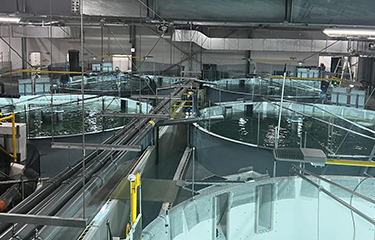Land-based salmon farming companies Proximar and Salmon Evolution both released production updates on 2 October indicating operations are meeting, or exceeding, expectations.
Proximar, which operates a land-based salmon recirculating aquaculture system (RAS) facility in Shizuoka Prefecture, Japan, announced in its first production update on the Oslo Børs that its growth rates are currently above its expectations. The company has a standing biomass of 11.5 metric tons (MT) at its facility, and said it is on track for its first ever harvest in Q3 2024.
“The fish is performing well and growing better than expected. This supports the quality of our production facility and chosen technology, operational structure, and fish farming competence,” Proximar CEO Joachim Nielsen said in a release. “The water quality remains good and stable, which we now see turning into good growth performance. This is very encouraging.”
Proximar began farming its first batch of salmon in October 2022. As of the end of Q2, the company had a standing biomass of 1.4 MT, which has since increased to its current 11.5 MT. The company added that it plans to have the first transfer of fish to its post smolt growout facility in Q4 2023.
The biomass is still a long way from Proximar’s targeted 5,300 MT of head-on gutted (HOG) production in phase one of its facility, but the company said that its water quality remains good, and the first batches are showing encouraging growth.
“We are very pleased to show the progress also in terms of biological development. The performance of the system is stable and mortality is lower than expectations,” Nielsen said. “We’re very encouraged by this development, as Proximar continues to prepare for first harvest in Q3 2024.”
In Norway, Salmon Evolution said in its latest operational update it is also experiencing strong biological performance at its land-based, flow-through salmon-farming facility.
The company said as of 30 September, 2023 that it has an all-time-high standing biomass of 2,100 MT – an increase of 101 percent compared to 30 June 2023. Net biomass production for Q3 was 1,290 MT, with a steady increase throughout the quarter. According to the company, based on numbers from the end of Q3, the company as near 1,600 MT to 1,700 MT of biomass production – almost 75 percent of the way to the company’s planned steady-state volumes.
"We are very pleased with the continued strong biological performance. During the third quarter we saw both all-time high biomass production and standing biomass,” Salmon Evolution CEO Trond Håkon Schaug-Pettersen said in a release. “Coupled with production costs trending in the right direction on back of higher production, and a historically strong salmon market, we very much look forward to the fourth quarter and our significant ramp-up in harvest volumes.”
The company said it harvested 185 MT of HOG salmon, a partial harvest of its third batch. The company said it pushed planned harvests out until Q4 2023 to “optimize harvest weights and price realization.”
“For the fourth quarter, the company is planning to increase harvest volumes significantly,” Salmon Evolution said.
Photo courtesy of Proximar







